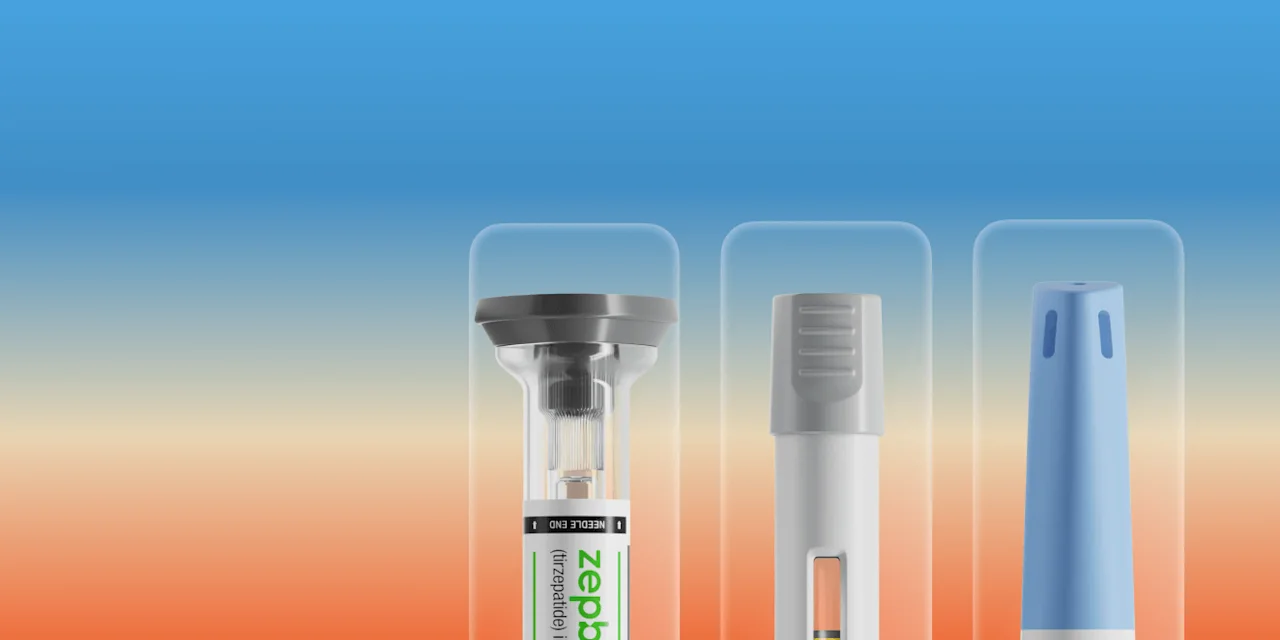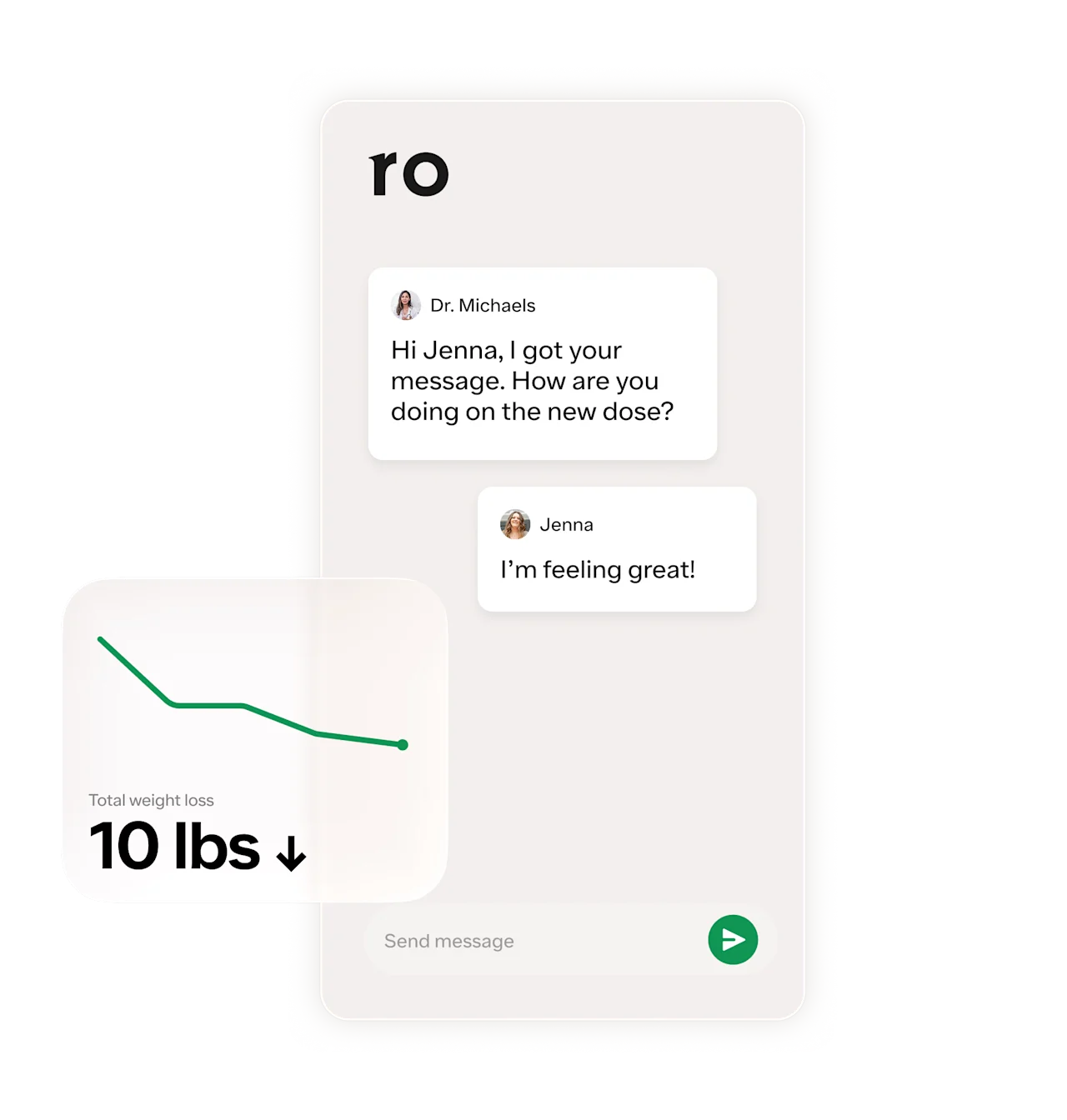Here's what we'll cover
Here's what we'll cover
Here's what we'll cover
When it comes to weight loss, people often talk about foods you should avoid or limit. But what about the items you should eat more of? If you’re looking to lose weight, focusing on high-fiber foods for weight loss is a stellar place to start.
Here, learn about the relationship between fiber and weight loss, 6 high-fiber foods for weight loss, and how incorporating these items into your diet can support your goals.
How does fiber help with weight loss?
There are two types of fiber: Soluble fiber and insoluble fiber. When soluble fiber enters the gut, it dissolves in liquid, forming a gel. Insoluble fiber does not dissolve in liquid but continues to move through the gastrointestinal tract.
Soluble fiber is particularly important for weight loss. It’s fermented by bacteria in the gut, which forms substances called short-chain fatty acids (SCFA). These SCFAs prompt the gut to release satiety hormones leptin, glucagon-like-peptide-1 (GLP-1), peptide YY, and cholecystokinin. What’s more, this lowers levels of ghrelin, the hormone that promotes hunger. These effects make you feel satisfied sooner, helping you eat less food and therefore, fewer calories.
Plus, fiber slows down digestion and, in turn, how quickly food moves through your GI tract. This can keep you fuller for longer, reducing hunger and how much food you eat.
High-fiber foods for weight loss
When incorporating more fiber into your diet, be sure to drink plenty of water. Doing so can help you avoid constipation (a common result of increased fiber intake) as well as improve digestive health, which, in turn, can support the nutrient’s weight loss promoting-effects (e.g. slowed digestion, stabilized blood sugar levels, growth of beneficial bacteria). It’s also a good idea to add high-fiber foods to your diet slowly to reduce the risk of constipation and other digestive side effects, such as bloating.
Here are some high-fiber foods to add to your plate:
1. Chickpeas
Chickpeas (aka garbanzo beans) are packed with fiber. According to the US Department of Agriculture (USDA), 1 cup of chickpeas offers 12.5 grams of fiber—nearly half of your daily recommended intake of 25-30 grams. This can support weight loss, as noted in a small study involving healthy women. In the study, researchers found that eating canned chickpeas suppressed appetite when compared to white bread consumption and consequently, the amount of overall food consumed. This effect was linked to the chickpeas’ high content of fiber and protein, another nutrient that can boost satiety.
Luckily, chickpeas are easy to incorporate into dishes. They’re delicious in salads, where they’ll add flavor, texture, and nutrients. You can also toss them with whole grains, like brown rice or quinoa, and roasted vegetables for a filling plant-based meal. If you have time to spare, use chickpeas to make vegetable burgers or roast them for a crispy snack.
In another small study, participants who consumed an afternoon snack of hummus—a creamy spread made of chickpeas—experienced more of a reduced appetite and increased satiety compared to those who ate a granola bar and those who didn’t eat a snack. Being that these effects can lead you to eat less food and overall fewer calories, the research suggests hummus (and, thus, chickpeas) may help promote weight loss.
2. Berries
Thanks to their high-fiber content, fruit can promote weight loss and weight maintenance when part of a balanced diet. One tasty option is berries, including blueberries, raspberries, strawberries, and blackberries. For example, according to the USDA, one cup of blueberries contains nearly 4 grams of fiber, while the same amount of raspberries offers nearly 10 grams.
More specifically, berries are high in soluble fiber, the type of fiber that can reduce appetite by increasing satiety hormones. One study found that eating blueberries increases levels of pancreatic polypeptide, a satiety hormone released by the pancreas.
To increase your intake of berries, add them to cereal, oatmeal, or yogurt. You can also blend them into smoothies or even add them to savory dishes, like salads, for a sweet touch.
3. Avocado
In case you need a reason to pay extra for guac, consider the fiber content of avocado. The fruit (yes, fruit) boasts nearly 10 grams of fiber per cup of sliced avocado, about a third of the daily recommended amount. This is great news for weight loss, as fiber can enhance fullness and potentially reduce your appetite.
Avocado is also high in healthy fats, particularly monounsaturated fats, which have been studied for their satiating effect, especially in overweight and obese individuals. For instance, in one study, avocado increased levels of GLP-1 (yes, that GLP-1)and peptide YY, two gut hormones that support satiety. Another small study found that eating half an avocado at lunch can enhance satiety and satisfaction in overweight adults, potentially reducing appetite and managing weight. Of course, remember that avocados contain calories and these calories should be accounted for as part of your overall diet.
4. Beans
When it comes to high-fiber foods for weight loss, you can’t go wrong with beans. Examples include black beans, pinto beans, red beans, and kidney beans, all of which are stellar sources of fiber. For instance, 1 cup of canned black beans contains 18 grams of fiber, while 1 cup of canned pinto beans offers 15 grams of fiber.
In a small study, black beans increased levels of cholecystokinin, a gut hormone associated with satiety. A scientific review also notes that beans are especially high in soluble fiber, a nutrient that balances the gut by nourishing beneficial bacteria in the GI tract. This may help control inflammation, a factor involved in weight and obesity.
Another perk? Beans are also packed with lean protein, another satiating nutrient. Try adding beans to salads, soups, stews, pasta dishes, or wraps.
5. Chia Seeds
Chia seeds might be tiny, but don’t let their size fool you. Just 2 ½ tbsp (or 1 ounce) of chia seeds has nearly 10 grams of fiber, which is why they’re worthy of a place in a high-fiber diet for weight loss. In one study, yogurt with chia seeds was shown to increase satiety more than yogurt alone and resulted in lower calorie intake afterward. The researchers attributed this effect to the high fiber content of chia seeds, which can reduce food intake after a meal by enhancing fullness.
Moreover, chia seeds contain omega-3 fatty acids; these “good” or healthy fats also suppress appetite, further adding to the weight loss benefits of chia seeds. You can incorporate chia seeds to yogurt, oatmeal, or smoothies for a filling boost.
6. Oats
One cup of cooked oats (think: oatmeal) contains 4 grams of fiber. In fact, some have even begun to call it "Oatzempic". According to one review, the ingredient is especially high in beta-glucan, a type of soluble fiber known for controlling appetite. Soluble fiber, including beta-glucan, slows digestion and increases satiety hormones, ultimately suppressing appetite. Another review notes that oats and beta-glucan can increase gut hormones that promote fullness (e.g. leptin, GLP-1, peptide YY), potentially helping you eat less and lose weight.
Oatmeal isn’t your only option for eating oats, though. Try adding oats to smoothies or using them to make homemade granola. You can even use oats to make a crunchy coating for baked salmon or chicken.
Other ways to lose weight safely
Eat a balanced diet. When it comes to weight loss, fiber is just one piece of the puzzle. It’s a good idea to focus on protein and healthy fats, which also increase fullness and promote weight loss. In general, a well-balanced diet is one that’s rich in fruits, vegetables, whole grains, lean protein (e.g. fish, chicken, fish), and foods high in healthy fats.
Get enough sleep. Your sleeping habits can affect your weight and overall health. Poor sleep can increase ghrelin (the hunger hormone) and decrease leptin (the satiety hormone). This can increase your appetite, potentially leading to weight gain. Aim to get 7–9 hours of sleep per night to support healthy weight.
Manage stress. Mental and emotional stress can raise levels of cortisol, the stress hormone. Chronically elevated cortisol levels can promote cravings for high-calorie “comfort foods,” increasing the likelihood of overeating and weight gain. Plus, stress can increase oxidative stress and inflammation, which are contributors to excess weight. To help manage stress, try to incorporate deep breathing, journaling, and meditation into your routine.
Exercise regularly. Physical activity burns calories, making it a critical part of losing weight. Not only that, but regular exercise can help build muscle and boost metabolism—two effects that can also play key roles in your weight loss journey. The common recommendation is to aim for at least 150 minutes of moderate aerobic activity (e.g. walking, running, cycling) per week. But some research suggests that simply incorporating more movement throughout the day can be beneficial for long-term help and weight management. It’s also a good idea to incorporate strength training at least twice a week to build muscle, which can increase your overall calorie burn.
Stay hydrated. In some folks, thirst can be confused for hunger, so be sure to drink plenty of water to keep your appetite in check. Staying hydrated may also increase metabolism and help burn calories, further supporting weight loss.
Consult an expert. To supercharge your weight loss efforts, chat with a healthcare provider about your goals and any additional options that can help you in your journey. If you have obesity or are overweight with a weight-related health condition, you might be a candidate for FDA-approved weight loss medications, such as Wegovy (semaglutide) and Zepbound (tirzepatide). For example, through Ro, your provider will assess your health history and weight loss goals to determine whether you’re qualified for treatment. And if you are, they’ll discuss potentially prescribing meds and create an individualized treatment plan based on your specific biology and needs.
Wegovy Important Safety Information: Read more about serious warnings and safety info.
Zepbound Important Safety Information: Read more about serious warnings and safety info.
Bottom line
Getting enough fiber is key for overall health, but it can also be important for weight loss. Its filling properties can reduce your appetite, potentially helping you eat less food and calories. However, it’s possible to overdo it with fiber, so add it to your diet slowly. If you have questions, it’s always a good idea to consult a pro, such as a healthcare provider or a registered dietitian.
DISCLAIMER
If you have any medical questions or concerns, please talk to your healthcare provider. The articles on Health Guide are underpinned by peer-reviewed research and information drawn from medical societies and governmental agencies. However, they are not a substitute for professional medical advice, diagnosis, or treatment.
References
Akbar, A. & Shreenath, A. P. (2023). High fiber diet. StatPearls. Retrieved from https://www.ncbi.nlm.nih.gov/books/NBK559033/
Ayaz, A., Akyol, A., Inan-Eroglu, E., et al. (2017). Chia seed (Salvia Hispanica L.) added yogurt reduces short-term food intake and increases satiety: randomised controlled trial. Nutrition Research and Practice, 11(5), 412-418. doi: 10.4162/nrp.2017.11.5.412. Retrieved from https://e-nrp.org/DOIx.php?id=10.4162/nrp.2017.11.5.412
Balfour, J. & Boster, J. (2023). Physical Activity and Weight Loss Maintenance. StatPearls. Retrieved from https://www.ncbi.nlm.nih.gov/books/NBK572051/
Bulsiewicz, W. J. (2023). The importance of dietary fiber for metabolic health. American Journal of Lifestyle Medicine, 17(5), 639– 648. doi: 10.1177/15598276231167778. Retrieved from https://www.ncbi.nlm.nih.gov/pmc/articles/PMC10498976/
Corney, R. A., Sunderland, C., & James, L. J. (2016). Immediate pre-meal water ingestion decreases voluntary food intake in lean young males. European Journal of Nutrition, 55(2), 815–819. doi: 10.1007/s00394-015-0903-4. Retrieved from https://pubmed.ncbi.nlm.nih.gov/25893719/
Cox, C. E. (2017). Role of Physical Activity for Weight Loss and Weight Maintenance. Diabetes Spectrum : A Publication of the American Diabetes Association, 30(3), 157–160. doi: 10.2337/ds17-0013. Retrieved from https://www.ncbi.nlm.nih.gov/pmc/articles/PMC5556592/
Dahiya, D. K., Renuka, Puniya, M., et al. (2017). Gut microbiota modulation and its relationship with obesity using prebiotic fibers and probiotics: A review. Frontiers in Microbiology, 8, 563. doi: 10.3389/fmicb.2017.00563. Retrieved from https://www.frontiersin.org/journals/microbiology/articles/10.3389/fmicb.2017.00563/full
Hill, D., Conner, M., Clancy, F., et al. (2021). Stress and eating behaviours in healthy adults: a systematic review and meta-analysis. Health Psychology Review, 16(2), 280–304. doi: 10.1080/17437199.2021.1923406. Retrieved from https://www.tandfonline.com/doi/full/10.1080/17437199.2021.1923406
James, L. J., Funnell, M. P., & Milner, S. (2015). An afternoon snack of berries reduces subsequent energy intake compared to an isoenergetic confectionary snack. Appetite, 95, 132–137. doi: 10.1016/j.appet.2015.07.005. Retrieved from https://www.sciencedirect.com/science/article/abs/pii/S0195666315003220
Kim, E., Zhao, Z., Rzasa, J. R., et al. (2021). Association of acute psychosocial stress with oxidative stress: Evidence from serum analysis. Redox Biology, 47, 102138. doi: 10.1016/j.redox.2021.102138. Retrieved from https://www.sciencedirect.com/science/article/pii/S2213231721002974
Laja García, A. I., Moráis-Moreno, C., Samaniego-Vaesken, M. L., et al. (2019). Influence of Water Intake and Balance on Body Composition in Healthy Young Adults from Spain. Nutrients, 11(8), 1923. doi: 10.3390/nu11081923. Retrieved from https://www.ncbi.nlm.nih.gov/pmc/articles/PMC6723835/
Paddon-Jones, D., Westman, E., Mattes, R. D., et al. (2008). Protein, weight management, and satiety. The American Journal of Clinical Nutrition, 87(5), 1558S–1561S. doi: 10.1093/ajcn/87.5.1558S. Retrieved from https://www.sciencedirect.com/science/article/pii/S0002916523236643
Rebello, C. J., O'Neil, C. E., & Greenway, F. L. (2016). Dietary fiber and satiety: the effects of oats on satiety. Nutrition Reviews, 74(2), 131–147. doi: 10.1093/nutrit/nuv063. Retrieved from https://www.ncbi.nlm.nih.gov/pmc/articles/PMC4757923/
Reister, E. J. & Leidy, H. J. (2020). An afternoon hummus snack affects diet quality, appetite, and glycemic control in healthy adults. The Journal of Nutrition, 150(8), 2214-2222. doi: 10.1093/jn/nxaa139. Retrieved from https://www.sciencedirect.com/science/article/pii/S0022316622022672?via%3Dihub
Reverri, E. J., Randolph, J. M., Kappagoda, C. T., et al. (2017). Assessing beans as a source of intrinsic fiber on satiety in men and women with metabolic syndrome. Appetite, 118, 75–81. doi: 10.1016/j.appet.2017.07.013. Retrieved from https://www.sciencedirect.com/science/article/abs/pii/S0195666316306493
Salleh, S. N., Fairus, A. A. H., Zahary, M. N., et al, (2019). Unravelling the effects of soluble dietary fibre supplementation on energy intake and perceived satiety in healthy adults: Evidence from systematic review and meta-analysis of randomised-controlled trials. Foods (Basel, Switzerland), 8(1), 15. doi: 10.3390/foods8010015. Retrieved from https://www.ncbi.nlm.nih.gov/pmc/articles/PMC6352252/
Sharma, S. P., Chung, H. J., Kim, H. J., et al. (2016). Paradoxical effects of fruit on obesity. Nutrients, 8(10), 633. doi: 10.3390/nu8100633. Retrieved from https://www.ncbi.nlm.nih.gov/pmc/articles/PMC5084020/
Shehzad, A., Rabail, R., Munir, S., et al. (2023). Impact of oats on appetite hormones and body weight management: A review. Current Nutrition Reports, 12(1), 66–82. doi: 10.1007/s13668-023-00454-3. Retrieved from https://www.ncbi.nlm.nih.gov/pmc/articles/PMC9930024/
Slavin, J. (2013). Fiber and prebiotics: mechanisms and health benefits. Nutrients, 5(4), 1417–1435. doi: 10.3390/nu5041417. Retrieved from https://www.ncbi.nlm.nih.gov/pmc/articles/PMC3705355/
Stote, K., Corkum, A., Sweeney, M., et al. (2019). Postprandial effects of blueberry (Vaccinium angustifolium) consumption on glucose metabolism, gastrointestinal hormone response, and perceived appetite in healthy adults: A randomized, placebo-controlled crossover Trial. Nutrients, 11(1), 202. doi: 10.3390/nu11010202. Retrieved from https://www.ncbi.nlm.nih.gov/pmc/articles/PMC6356777/
Swift, D. L., Johannsen, N. M., Lavie, C. J., et al. (2014). The role of exercise and physical activity in weight loss and maintenance. Progress in Cardiovascular Diseases, 56(4), 441–447. doi: 10.1016/j.pcad.2013.09.012. Retrieved from https://www.ncbi.nlm.nih.gov/pmc/articles/PMC3925973/
Thompson, S. V., Hannon, B. A., An, R., et al. (2017). Effects of isolated soluble fiber supplementation on body weight, glycemia, and insulinemia in adults with overweight and obesity: a systematic review and meta-analysis of randomized controlled trials. The American Journal of Clinical Nutrition, 106(6), 1514-1528. doi: 10.3945/ajcn.117.163246. Retrieved from https://ajcn.nutrition.org/article/S0002-9165(22)02702-2/fulltext
Tucker, L. A. (2020). Bean consumption accounts for differences in body fat and waist circumference: A cross-sectional study of 246 women. Journal of Nutrition and Metabolism, 2020, 9140907. doi: 10.1155/2020/9140907. Retrieved from https://pubmed.ncbi.nlm.nih.gov/32587765/
van Egmond, L. T., Meth, E. M. S., Engström, J., et al. (2023). Effects of acute sleep loss on leptin, ghrelin, and adiponectin in adults with healthy weight and obesity: A laboratory study. Obesity (Silver Spring, Md.), 31(3), 635–641. doi: 10.1002/oby.23616. Retrieved from https://onlinelibrary.wiley.com/doi/10.1002/oby.23616
Weickert, M. O. & Pfeiffer, A. F. H. (2018). Impact of dietary fiber consumption on insulin resistance and the prevention of type 2 diabetes. The Journal of Nutrition, 148(1), 7-12. doi: 10.1093/jn/nxx008. Retrieved from https://www.sciencedirect.com/science/article/pii/S0022316622108722?via%3Dihub
Wien, M., Haddad, E., Oda, K., et al. (2013). A randomized 3x3 crossover study to evaluate the effect of Hass avocado intake on post-ingestive satiety, glucose and insulin levels, and subsequent energy intake in overweight adults. Nutrition Journal, 12, 155. doi: 10.1186/1475-2891-12-155. Retrieved from https://nutritionj.biomedcentral.com/articles/10.1186/1475-2891-12-155
Zafar, T. A. & Kabir, Y. (2016). Chickpeas suppress postprandial blood glucose concentration, and appetite and reduce energy intake at the next meal. Journal of Food Science and Technology, 54(4), 987-994. doi: 10.1007/s13197-016-2422-6. Retrieved from https://europepmc.org/article/pmc/5336455
Zhu, L., Huang, Y., Edirisinghe, I., et al. (2019). Using the avocado to test the satiety effects of a fat-fiber combination in place of carbohydrate energy in a breakfast meal in overweight and obese men and women: A randomized clinical trial. Nutrients, 11(5), 952. doi: 10.3390/nu11050952. Retrieved from https://www.mdpi.com/2072-6643/11/5/952













